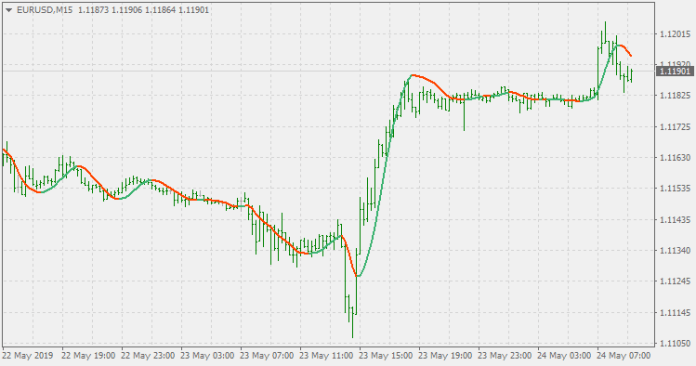Traditional moving averages, like the Simple Moving Average (SMA) and Exponential Moving Average (EMA), often suffer from a critical drawback: lag. This lag occurs because they average past price points, which can make them slow to react to recent price movements. Additionally, achieving a smooth line often requires using longer periods, further amplifying the lag effect.
The HMA tackles this challenge by employing a unique three-fold calculation method. It incorporates elements of both weighted moving averages (WMAs) and double smoothing to achieve the coveted balance between responsiveness and smoothness.
In-Depth Look at The Hma Calculation
While the underlying mathematical formula might seem intimidating, understanding the core principles behind the calculation can empower you to interpret the HMA’s behavior more effectively.
Here’s a simplified breakdown of the process:
Calculating two WMAs
- The first WMA uses a specific period length (defined by the user) to average past closing prices.
- The second WMA uses half the period length to average the values of the first WMA.
Double Smoothing
- The final step involves calculating another WMA, this time using the average of the two previously calculated WMAs.
- This three-layered approach effectively reduces lag while maintaining a smooth line, providing traders with a clearer visual representation of the underlying trend.
Interpreting Hma Signals For Trading Decisions
While the HMA is a valuable tool, it’s crucial to remember that it’s not a crystal ball. It doesn’t guarantee future price movements, and relying solely on its signals can be risky. However, by understanding how to interpret its behavior, you can gain valuable insights to inform your trading decisions.
Here are some common interpretations of HMA signals:
- Upward Trend: When the HMA slopes upwards, it generally indicates an underlying bullish trend. This can be a potential signal for long entries (buying) or confirmation of existing long positions.
- Downward Trend: A downward-sloping HMA suggests a bearish trend, potentially signaling short entry (selling) opportunities or prompting the closing of long positions.
- Crossovers: Similar to other moving averages, the HMA can generate crossover signals when it crosses above or below the price chart. A bullish crossover occurs when the HMA crosses above the price, potentially indicating a trend reversal to the upside. Conversely, a bearish crossover happens when the HMA falls below the price, suggesting a potential trend change to the downside.
Advantages and Disadvantages Of Using The Hma Indicator
Advantages
- Reduced Lag: Compared to traditional moving averages, the HMA offers a significant advantage in terms of reduced lag. This allows it to react more promptly to recent price movements, potentially providing earlier entry and exit signals.
- Improved Smoothing: Despite its responsiveness, the HMA still maintains a relatively smooth line, making it easier to identify potential trends and avoid getting caught up in short-term market noise.
- Versatility: The HMA can be applied to various markets and timeframes, making it a versatile tool for traders of different styles and asset classes.
Disadvantages
- Not a Standalone Indicator: As mentioned earlier, the HMA should not be used in isolation. It’s crucial to combine it with other indicators and fundamental analysis for a comprehensive understanding of the market.
- Potential for False Signals: Like any other indicator, the HMA can generate false signals, especially during periods of high market volatility. It’s essential to use proper risk management techniques to mitigate potential losses.
- Subjectivity in Interpretation: Interpreting the HMA’s signals can involve a degree of subjectivity, especially for new traders. Practicing on a demo account and refining your understanding can help you develop your interpretation skills.
Advanced HMA Strategies and Trading Techniques
While the basic principles of using the HMA are straightforward, there are also advanced strategies you can explore to refine your analysis and potentially enhance your trading results. Here are a few examples:
Combining With Other Indicators
The HMA can be combined with other technical indicators, such as the Relative Strength Index (RSI) or Bollinger Bands, to create a confluence of signals and increase your confidence in potential trade setups.
Dynamic Support and Resistance
The HMA can sometimes act as a dynamic support or resistance level, especially during periods of trending markets. When the price consistently bounces off the HMA, it can indicate potential support or resistance zones. However, it’s crucial to remember that these levels can be broken, and confirmation from other indicators or price action patterns is always recommended.
Identifying Divergences
Divergences between the HMA and price action can offer valuable insights. For instance, a bullish divergence occurs when the price creates lower lows while the HMA forms higher lows, potentially suggesting a weakening downtrend and a possible trend reversal. Conversely, a bearish divergence happens when the price forms higher highs while the HMA creates lower highs, potentially indicating a weakening uptrend and a possible reversal to the downside
How to Trade with Hull Moving Average Indicator
Buy Entry
- Bullish Crossover: Enter a long position when the HMA crosses above the price chart. This potentially signals a trend reversal to the upside.
- Stop-Loss: Place your stop-loss order below the recent swing low, or consider placing it below the HMA for a tighter stop.
- Take-Profit: Target a take-profit level based on your risk-reward ratio and technical analysis. You can use Fibonacci retracement levels, chart patterns, or other indicators to determine potential take-profit zones.
Sell Entry
- Bearish Crossover: Enter a short position when the HMA crosses below the price chart. This potentially signals a trend reversal to the downside.
- Stop-Loss: Place your stop-loss order above the recent swing high, or consider placing it above the HMA for a tighter stop.
- Take-Profit: Target a take-profit level based on your risk-reward ratio and technical analysis. You can use Fibonacci retracement levels, chart patterns, or other indicators to determine potential take-profit zones.
Conclusion
Hull Moving Average (HMA) has established itself as a valuable tool for MT4 traders seeking a balance between responsiveness and smoothness. By understanding its unique calculation method, customization options, and how to interpret its signals, you can leverage the HMA to inform your trading decisions and potentially improve your overall trading experience.
Recommended MT4/MT5 Brokers
XM Broker
- Free $50 To Start Trading Instantly! (Withdraw-able Profit)
- Deposit Bonus up to $5,000
- Unlimited Loyalty Program
- Award Winning Forex Broker
- Additional Exclusive Bonuses Throughout The Year
>> Sign Up for XM Broker Account here <<
FBS Broker
- Trade 100 Bonus: Free $100 to kickstart your trading journey!
- 100% Deposit Bonus: Double your deposit up to $10,000 and trade with enhanced capital.
- Leverage up to 1:3000: Maximizing potential profits with one of the highest leverage options available.
- ‘Best Customer Service Broker Asia’ Award: Recognized excellence in customer support and service.
- Seasonal Promotions: Enjoy a variety of exclusive bonuses and promotional offers all year round.
>> Sign Up for FBS Broker Account here <<
(Free MT4 Indicators Download)
Click here below to download:





